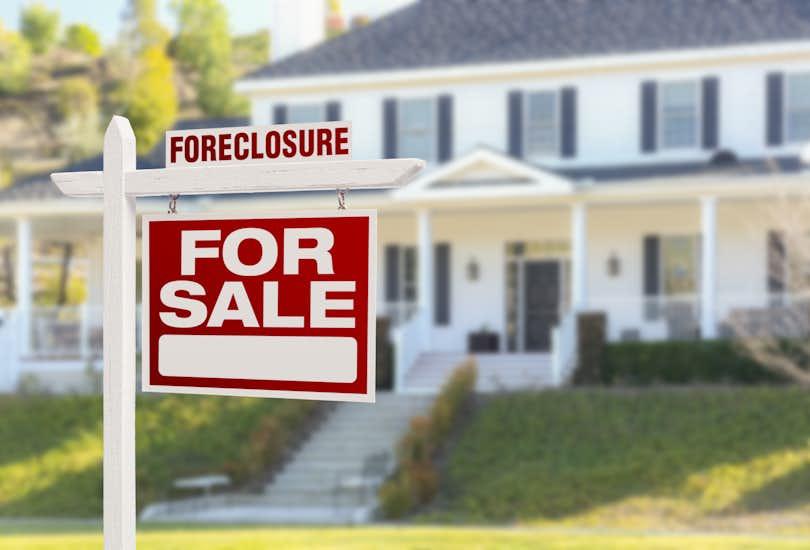The number of U.S. homes entering foreclosure has nearly tripled from over a year ago. But rather than a sign of a housing bubble, this could be a return to normal.
According to data firm ATTOM, lenders started foreclosure proceedings on 23,952 properties in August. That's a 187% jump over this time last year, bringing monthly foreclosure starts nearly back to pre-pandemic levels.
Factoring in properties that moved from default notices to scheduled auctions or repossessions, a total of 34,501 properties were in some stage of foreclosure in August, an increase of 118% year-over-year.
August foreclosure data
While the jump in foreclosure activity may seem dramatic, these figures are still "relatively low compared to historic averages," says ATTOM's executive vice president of market intelligence, Rick Sharga. He and other industry experts generally agree that we're not headed for a housing crash — at least not anything like we saw in 2008.
"The current increase in foreclosures to pre-pandemic levels was expected," says Indiana-based realtor Chuck Vander Stelt. "As the safety nets to defer mortgage payments and stop foreclosure processes are removed, those who were struggling before implementation of those programs are back to struggling to keep up with their house payments."
"Foreclosures may have increased, but we are not headed for a bubble," agrees Mike Hardy, managing partner at Churchill Mortgage. "If mortgage rates drop significantly again to 2021 levels, I would have concerns, but rates rising is the best thing that could have happened to slow the appreciation pace and allow inventory to catch up."

What does the rise in foreclosures mean for home buyers and sellers?
"Over 90 percent of borrowers in foreclosure have positive equity in their homes," notes Sharga, who suggests that homeowners would "benefit from selling these properties at a profit rather than risk losing everything to a foreclosure auction or lender repossession."
With fewer than 4,000 homes entering repossession across the country, buyers shouldn't expect to see an abundance of cheap bank-owned popping up on auction sites. What they could see, instead, are more opportunities to purchase homes in pre-foreclosure — particularly in areas with the highest rates of foreclosure filings.
Areas with the highest rates of foreclosure in August 2022
The further behind a seller gets on their mortgage, the more motivated they'll be to sell before they enter foreclosure. The tight timeline opens the door for buyers to get something of a bargain while helping the seller get out from under financial duress.
"Investors that are well capitalized and can afford to invest are looking at a series of great opportunities," says Ganeshram. "From fix and flips to outright opportunities for long-term rental cash flow, foreclosures mean underpriced inventory that needs to move quickly."
Ganeshram suggests that individual buyers with access to cash may find similar opportunities to pay below market value for a home. However, beyond those one-off opportunities, the recent uptick in foreclosures may not create much of a ripple across the market in terms of easing the current housing shortage.
"After a few months of rapidly increasing inventory, we saw a slight dip in inventory in the last couple weeks, down to 553,000 single family residences" says Hardy. "This is partially due to buyers showing hesitancy to buy and sellers resistant to sell and give up very cheap mortgages. Based on pent-up buyer demand and well-positioned hesitant sellers, I expect a lateral move or gentle decline in inventory the remainder of the fall season."
A decline in new listings, coupled with a pullback on new construction among homebuilders, is likely to keep inventory low for some time.
Where will foreclosure activity go from here?
Whether the rate of foreclosures will continue its upward trend or simply level off at its pre-pandemic rate is yet to be determined.
Many analysts attribute the recent rise in foreclosure filings to the end of pandemic-era protections for homeowners, but other industry insiders think there's more to the story.
"While the expiration of moratoriums on foreclosures may be exacerbating the return to pre-pandemic foreclosure levels, it is not the only factor at play," says mortgage broker Alan Harder. "Inflation, interest rates, and other economic factors are also exerting downward pressure on the housing market."
"In order for a large wave of foreclosures to occur, there needs to be further economic deterioration," suggests realtor Chuck Vander Stelt. "A meaningful rise in employment and a sustained elevated unemployment rate would be the most likely indicators of a future increase in foreclosures."
However, as Shri Ganeshram, CEO of real estate investment company Awning, points out, many homeowners are already starting to see downsizing among their employers. Coupled with high inflation, he expects that the number of homeowners defaulting on their mortgages is likely to keep growing.
Yet, "even a healthy housing market has foreclosures," NerdWallet home and mortgage expert Holden Lewis told MarketWatch last month. For now, consider the latest foreclosure news another milestone on a long journey back toward normalcy.


